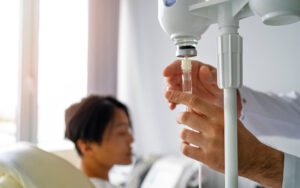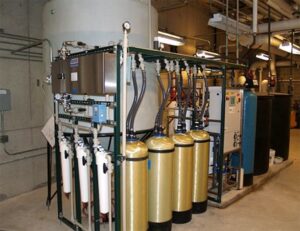Hemodialysis is a life-saving treatment requiring specialized equipment to perform right. Moreover, it requires considerable and constant upkeep, needing to ensure that the machine isn’t producing any defective or harmful ultrapure water, among other things. The need for extremely rigid purity thresholds is necessary due to the nature of this process, but the constant need for maintenance is a system limitation that is holding back this treatment option from being as effective as it can be.
So, let’s take a look at these dialysis water treatment systems, and just how difficult it is to make ultrapure water live up to its name.
Ultrapure Water
Ultrapure water refers to highly purified water with very stringent standards on which to achieve it, removing almost all contaminants, such as bacteria and other inorganics, from the water. Whether anything is dissolved or not, volatile or otherwise, inert or highly reactive, ultrapure water has it in the lowest concentrations of any other water type.
And it’s important to understand this term–concentrations. Ultrapure water isn’t ‘purified’ in literal terms. In fact, almost all water isn’t pure at all, simply because water is an excellent solvent and dissolves many substances quite effectively. Even the ‘pure’ water we drink is filled with additives and other chemicals that aren’t harmful simply because they have a much lower concentration of it.
By removing the conductive aspects from water through water deionizer systems, ultrapure water is made non-conductive. This removal of its solutes makes it more susceptible to absorbing carbons, making it highly acidic. That means the ultrapure water also needs to be very carefully stored and used for medical purposes, especially in an invasive procedure such as hemodialysis.
The Issue with Variable Standards
Ultrapure water has more than one set of guidelines when it comes to the minimum purity thresholds and standards. Keeping up with the various standards has its own issues, but it is made less of a headache by the fact that these aren’t too different from each other. Each has its own name for ultrapure water as well, with some calling it Deionized Water (DI), Water for Injection (WFI), and more.
Now, water treatment systems must be regularly serviced and checked for adherence to water quality standards, such as those set by the Association for the Advancement of Medical Instrumentation (AAMI). However, the AAMI is not the only one setting these standards.
Let’s use an example using hemodialysis machines and their dialysis water treatment systems. The problem with variable standards is that it makes it difficult for patients, healthcare providers, and hemodialysis machine manufacturers to be on the same page. Moreover, a manufacturer must conform to various standards, which can add to the amount of complication in any process. A hydro water company making hemodialysis machines will then have to consider conforming to new standards, which can potentially add new costs to the machines.
One of the most critical requirements from these standard-setting institutions is that a single dialysis machine should, on its own, be able to handle the entire dialysis process without requiring any additional equipment, this only adds to the problem. Maintaining ultrapure water quality is essential, and different standards make it more complex to achieve this, which also leads to issues in maintaining that quality. As any variations in water quality can affect the consistency and reliability of experiments, manufacturing processes, or medical procedures, so do the standards of quality levels.
Maintenance Requirements for Hemodialysis Machines
Machine maintenance is critically important in producing ultrapure water for various applications, including laboratory work, pharmaceutical manufacturing, and, most importantly, hemodialysis. Ultrapure water requires purification to an exceptionally high degree, typically with very low levels of impurities, ions, and contaminants. However, even with the best systems in place, if they aren’t well maintained, the results will only be less and less effective.
Why is maintenance necessary? Well, why does anything need to be maintained? For one–among many benefits–is that regular maintenance helps ensure that the water treatment system functions optimally, maintaining the desired level of purity consistently over time. Any malfunction or degradation in the system can lead to impurities entering the water, compromising its purity and therefore, compromising patient health.
Dialysis is a procedure that somewhat replaces the kidney functions, acting as a purifier for your internal bloodstream. That means the water in hemodialysis will not just enter your body but your bloodstream–directly. Anything less than the most pure form of water is putting patients at a serious health risk. That is why maintaining purity is so critically important. Hemodialysis machines should also be cleaned, disinfected, and sterilized according to established protocols before and after each use. This helps prevent infection and cross-contamination, and in such a procedure, it’s clear why.
The Benefits are Numerous, Without a Doubt
The presence of contaminants, such as ions, particles, or organic matter, can impact the quality of ultrapure water. A higher concentration of one contaminant is all that matters, even if other contaminants are almost completely removed. This is important because the ultrapure water still has to pass through certain objects that can get contaminated. Keeping the dialysis water purification systems unmaintained is like using a dirty cloth to clean your desk. You might still get it clean, but you’ll leave plenty of dirt behind you can’t properly see. Proper maintenance prevents the buildup of contaminants in the system and helps avoid cross-contamination.
It also helps keep the equipment going for longer. Regular servicing and cleaning can prevent wear and tear, corrosion, and damage to components, ensuring the longevity of the system. Considering just how expensive hemodialysis treatment is, keeping costs down as much as possible should be a priority, not just a bonus, so this maintenance benefit is a crucial one too.
More benefits include:
- Reduced/Eliminating Downtime: Hemodialysis is a fairly regular treatment, requiring you to have a multiple-hour session several times a week at least. That means if a machine isn’t working or is sent for repair, it can seriously disrupt a patient’s schedule, especially if they are using a home dialysis machine. It can cause even more issues in hospitals and laboratories, as one machine will likely be used by multiple patients in a given week or set of days.
- Regulatory Compliance: The ultrapure water standards for hemodialysis are strict, and for good reason. Anything, where a decimal’s difference can lead to patient mortality, will likely have very stringent standards to begin with, and regulatory compliance is one of the first and most regular issues any hydro water company will face.
The problem isn’t that maintenance is required, but that it’s required as often as it is. For example, there are daily, weekly, and monthly standards for dialysis machine maintenance, including its water purification systems. In addition, ultrapure water and it’s purity is measured in a way that it is determined during the purification process rather than after the fact, adding to the necessity of keeping things maintained. In essence, slipups are regular, and one won’t properly know the inefficacy and high concentration of contamination in their ultrapure water until after the fact.
The Core Issue of ‘Too Much Maintenance
The guidelines for ultrapure water in hemodialysis, as mentioned above, state that daily maintenance is required both before and after each use. Visual inspections, readings, verification of existing systems working as intended, and sanitization as necessary must be performed daily.
Weekly maintenance requires that pretreatment components are checked and cleaned, conditions of the components and internals are checked, and various seals, valves, and gaskets are inspected.
Pumps, lubrication seals, RO membranes, and sensor calibration has to be done on a monthly basis. Testing components may also be required in subsequent months, and more often than not, many critical components may also require replacement, such as the UV lamps. Clearing out the carbon filters for replacement is also a fairly regular process, in addition to documentation.
Maintaining comprehensive records of maintenance, including dates of service, replacement of components, and any issues or repairs performed, is a regulatory requirement. These records are essential for regulatory compliance and auditing. but these maintenance requirements point to one growing thing.
There is simply too much of it.
The argument isn’t that there should be less compliance but that there shouldn’t be so much necessary. The process has plenty of routes for additional simplicity to be added, and they should be looked at. It’s not about the standard in itself, but that the standards open the discourse of the amount of maintenance required for such a regular and life-saving operation. Acute kidney failure doesn’t get better unless your entire kidney is replaced, which can take years, depending on where you are on the waiting list.
Maintenance is an ongoing process, and in hemodialysis, it is a very critical ongoing process, so it can be said that institutions bringing these standards and manufacturers should work to reduce the overall gap between the different guidelines and have a uniform maintenance method so it can be reduced within the system itself.




